Introduction
Of the major camera makers Sony is the only firm with two highly developed camera systems running in parallel. While it’s true the SLT range of cameras and lenses isn’t as extensive as either the Canon or Nikon DSLR systems it is further ahead than those firm’s in the mirrorless market. Sony is also competing with the joint Panasonic/Olympus MFT mirrorless system which when combined offers a formidable range of high-performance telecentric lens designs. Fuji’s X-system is also making inroads and has a very attractive lens range that’s expanding quickly.
However, none of those makers has yet to challenge the popular EVF-equipped NEX-7 with its class-leading pixel count. While the gap is narrowing, the performance of the 24-Mpix APS-C size CMOS sensor in the Sony NEX-7 means that model is currently highest ranking mirrorless camera in our database. After measuring the performance characteristics of camera, we’ve now had assessed it with a range of lenses and have put together a concise guide to assist the reader in selecting the best performing models, while also pointing out some the more accessibly priced value options.
We’ve tested the NEX-7 with 14 different lens models consisting of both fixed focal primes as well as zooms with a range of focal lengths, including Sony made lenses and those from third parties. Listed below are some of the lenses we’ve analyzed. We’ve included performance data on some of the latest models:
- Sony Carl Zeiss Sonnar T* E 24mm F1.8 ZA
- Sony E 50mm F1.8 OSS
- Sony E 30mm F3.5 Macro
- Sigma 19mm F2.8 EX DN Sony E
- Sigma 30mm F2.8 EX DN Sony E
- Sony E18-200mm f/3.5-6.3
- Sony E 16-50mm f/3.5-5.6
- Sony E 18-200mm f/3.5-6.3 LE
- Tamron 18-200mm F/3.5-6.3 Di III VC Sony E
Best Prime for your Sony NEX-7:
 |
 |
 |
| Sony E 50mm F1.8 OSS | 300 | 23 |
| Sony Carl Zeiss Sonnar T* E 24mm F1.8 ZA | 1000 | 22 |
| Carl Zeiss Planar Touit 1.8/32 Sony E | 1000 | 22 |
| Sony E 35mm f/1.8 | 450 | 21 |
| Sigma 30mm F2.8 EX DN Sony E | 189 | 21 |
| Sigma 19mm F2.8 EX DN Sony E | 140 | 18 |
| Sony E 20mm F2.8 | 350 | 17 |
| Carl Zeiss Distagon Touit 2.8/12 Sony E | 1250 | 17 |
| Sony E 30mm F3.5 Macro | 250 | 15 |
With an overall DxOMark Score of 23 points, the best-performing Sony E-mount lens in our database at the time of publishing is the $300 stabilized Sony E 50mm f/1.8 OSS. This is closely followed by the Sony Zeiss Sonnar T* E 24mm f/1.8 ZA and the recently reviewed ZEISS Planar Touit 1,8/ 32 Sony E, both achieving a DxOMark score of 22 points. Representing particularly good value is the $189 Sigma 30mm f/2.8 EX DN Sony E (although this has recently has been revised as an Art series lens, which we’ve not yet tested).
Best Zoom lenses for the Sony NEX-7:
 |
 |
 |
| Sony E 10-18mm f/4 | 850 | 14 |
| Sony E18-200mm f/3.5-6.3 | 800 | 13 |
| Sony E 16-50mm f/3.5-5.6 | 350 | 12 |
| Sony E 18-200mm f/3.5-6.3 LE | 850 | 11 |
| Tamron 18-200mm F/3.5-6.3 Di III VC Sony E | 739 | 10 |
Zoom lenses are still fairly scant but of those tested the Sony E 10-18mm f/4 is beginning to approach the ZEISS and Sony wide-angle equivalents with a DxOMark score of 14 points. And, incidentally, compared to retro-focus APS-C format lenses for DSLRs that and the Sony E 18-200mm f/3.5-6.3 comes close to the best wide-angle measured on the Canon EOS 100D. However, it’s not all good news as despite the design benefits over retro-focus lenses substantially reducing the size of the Sony E-mount zooms remains a challenge.
From the list above it’s easy to see the Sony E 16-50mm f/3.5-5.6 is good value at $350 by comparison, achieving a pretty good DxOMark Score of 12 points.
Sony E 50mm F1.8 OSS mounted on Sony NEX-7:
One of the few E-mount lenses to boast optical image stabilization (OSS or Optical SteadyShot as Sony call it) the Sony E 50mm f/1.8 OSS has the best DxOMark score of the bunch. While that score is used for benchmarking it’s always a good idea to examine the individual metric scores. Chromatic aberration and distortion are extremely well controlled, while both transmission and vignetting are at the expected levels for a lens like this. As for sharpness, the pair achieve a good (but not great) 13P-Mpix score out of a maximum of 24P-Mpix. Given the spec and performance, at $350 the lens is good value.
Sigma 19mm F2.8 EX DN Sony E Vs Sony E 20mm F2.8 both mounted on Sony NEX-7:
One of the best value of those tested in our database (and sadly no longer available, having already been revised and soon to be tested) is the Sigma 19mm f/2.8 EX DN Sony E. As the equivalent angle of view to a 28mm (in 35mm format), this lens only costs $140 and yet has good sharpness, low distortion and not too bad chromatic aberration. Compared to the Sony equivalent offering, the Sigma offers similar sharpness but while the former is nicely compact in size it’s at the expense of vignetting, and distortion. Not only that the Sony pancake, appealing as it is, is more than twice the sticker price.
Sony Carl Zeiss Sonnar T* E 24mm F1.8 ZA Versus Sony E 20mm F2.8 Versus Sony E 35mm f/1.8 all three mountedon Sony NEX-7:
Of all the E-mount lenses none has quite the same reputation as the Sony Zeiss Sonnar T* E 24mm f/1.8 ZA. As the equivalent angle of view to a 35mm lens, this $1000 optic is jointly ranked second with the new ZEISS Touit 1,8/32, and achieves just one point less in than the Sony 50mm moderate telephoto (a lens that’s far easier to make and correct for optical shortcomings). In fact, with a 13P-Mpix score it shares similar levels of sharpness as the Sony 50mm. It also outperforms Sony’s other shorter focal length lenses, including the 35mm f1.8 (which is the equivalent to a 50mm and one that we would expect to score highly). Distortion levels are quite low, as is vignetting. The only downside is Chromatic Aberration, which could be lower given the price.
Sony E 16-50mm f3.5-5.6 mounted on Sony NEX-7 Versus Panasonic LUMIX G VARIO 14-42mm / F3.5-5.6 II ASPH. / MEGA O.I.S.mountedon Panasonic GH2:
Comparing kit zooms between the Sony and rival Panasonic offering, we can see the smaller sensor in the Lumix GH-2, with its lower pixel count, is more efficient than the NEX-7. While the Sony E16-50mm has a wider angle of view than the Panasonic, the two share similar behaviour with regards to distortion, albeit less on the latter which is to be expected. However, the Panasonic has lower levels of vignetting and Chromatic Aberration and is $100 less. All the same, given the small size and handy focal range, the Sony lens is a decent performer.
Sigma 30mm F2.8 EX DN Sony E Vs Sony E 30mm F3.5 Macro both mounted on Sony NEX-7:
Bringing up the rear of our database is a lens that should score highly. However, while transmission, distortion and vignetting of the $250 Sony E 30mm f/3.5 Macro are all within acceptable limits, low sharpness and high-levels of chromatic aberration (two characteristics that should really be absent in a macro) result in a slightly disappointing DxOMark score of 15 points.
While not a macro lens, the equivalent focal length from Sigma on the other hand (and again, already no longer available in the guise tested – though the new Art model is soon to be added to our database) has more consistent sharpness across the field and lower levels of troublesome Chromatic Aberration. If you have no need of the Sony’s genuinely useful 1:1 macro capabilities, at $189 vs. $250 the Sigma is a better value proposition for general photography.
Sony E 50mm F1.8 OSS mounted on Sony NEX-7 Vs Pentax smc DA 50mm f1.8 mounted on Pentax K-5
We thought it would be of interest to compare image quality with a retro-focus model designed for the same sensor format. Please bear in mind, it’s not quite a straight comparison, as the Sony lens on a NEX-7 with its 24Mpix sensor has an advantage in resolving power over Pentax combination (we’ve yet to asses this Sony lens with the lower pixel count NEX-6, and there are still too few equivalent primes for APS-C DSLRs). However, while the fact remains the Sony combination is sharper, we can’t attribute all the benefit in pixel count to the higher score. As a result, the Sony E50mm f/1.8 appears to have a slight advantage in sharpness levels, particularly at full-aperture. At the same time, the Pentax has excellent control of vignetting, though to be fair it’s not something that gets a lot of weighting in our DxOMark Score (as it’s easily compensated for in software or in-camera).
Sony E 18-200mm f/3.5-6.3 LE Versus Tamron 18-200mm F/3.5-6.3 Di III VC Sony E Versus Sony E18-200mm f/3.5-6.3:
If we look at the three super-zooms in our database measured on the NEX-7 the DxOMark Scores are similar but, as always, it pays to look at the fine print. As a straight comparison we can see the Sony E18-200mm f/3.5-6.3 is a better performer than the lighter, slightly cheaper LE version. Not only is it sharper (albeit mainly in the centre) but it has better transmission overall and lower Chromatic Aberration. The only downside Image Quality-wise is that the pricier, bulkier lens has more distortion (it’s particularly noticeable at 200mm).
Sony’s E-mount range is gaining momentum with both third-party makers and Sony contributing new models recently. Designing lenses smaller than their retro-focus equivalents remains a challenging prospect, however, Sony has introduced a couple of ‘pancake’ type primes and compact zooms that perform well. The range also includes several high-performance primes, although image quality assessment based on the 24-Mpix Sony NEX-7 means that sharpness scores aren’t quite as expected. Whether that’s due to the limitations of current lens designs only time will tell.
Do you have a favorite lens for a Sony NEX-7? If so, please tell us in the comments below.


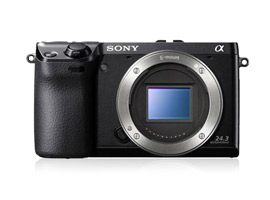

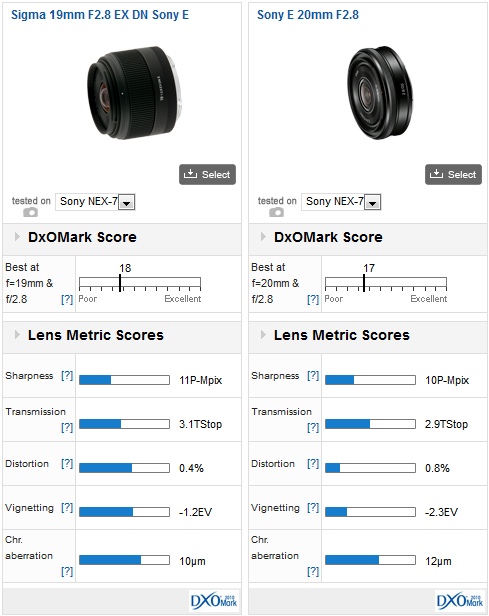
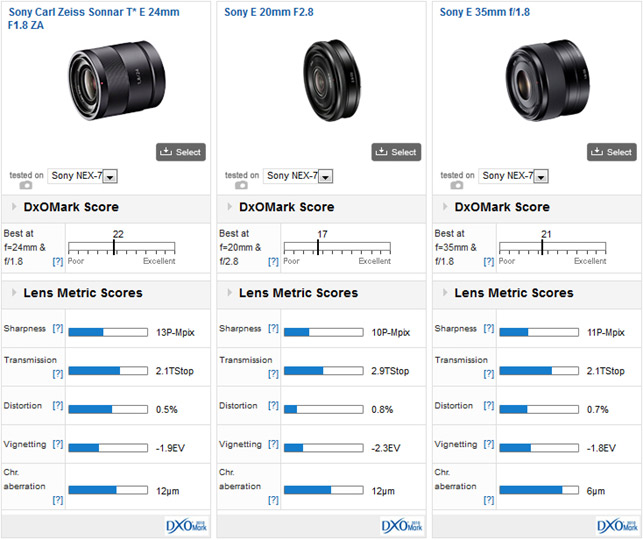


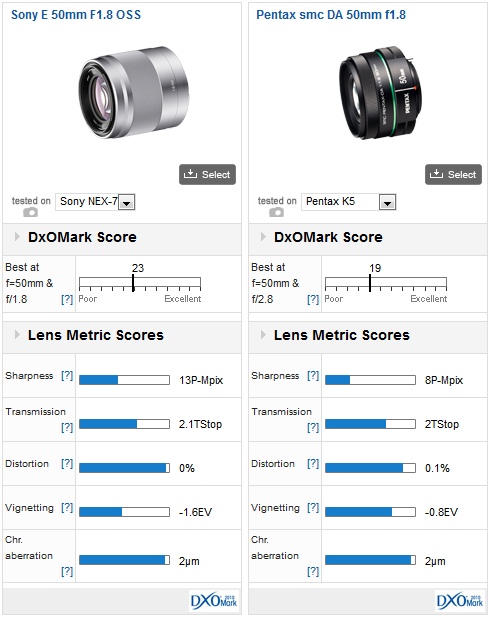
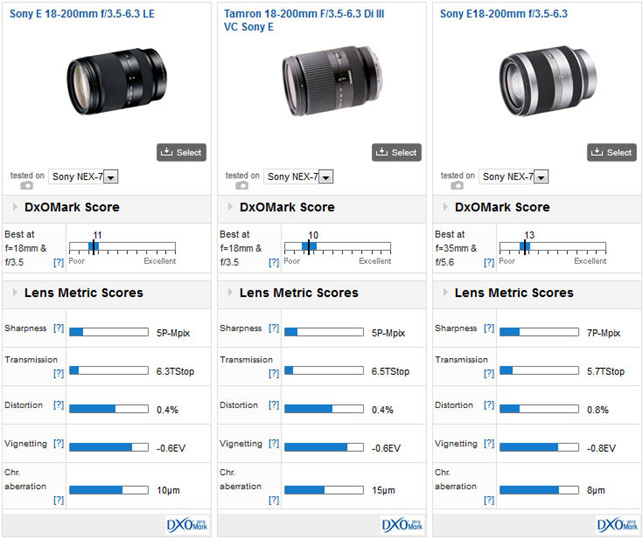
DXOMARK encourages its readers to share comments on the articles. To read or post comments, Disqus cookies are required. Change your Cookies Preferences and read more about our Comment Policy.